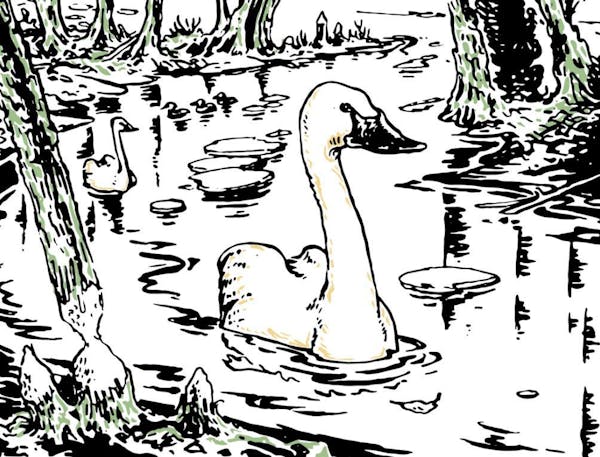The Department of Natural Resources has rejected the latest plea from a citizens group to formally review alleged environmental threats from a proposed 764-mile back-roads driving route that the agency intends to open across northern Minnesota for four-wheel drive owners.
The petitioners are concerned that the so-called Border to Border Touring Route will unduly escalate traffic of high-impact vehicles on natural surface roads that snake through remote forest lands amid pristine waters and sensitive wetlands. The group —Citizens for Sustainable Off-Roading — foresees harmful sediment getting splattered into fragile trout streams; vehicles sparking forest fires; rare species suffering from environmental damage; vehicles spewing air and noise pollution; the spread of invasive species; and an intensified level of motorized intrusions upon bird-watchers, hunters, sightseers and other low-impact recreational users of the roads.
In denying the group's request for an Environmental Assessment Worksheet (EAW), the DNR said the petitioners failed to demonstrate that the project may have the potential for significant environmental effects. The decision emphasized that the route will be set on existing roadways and that the project does not call for the construction of new roads or trails.
Designed for highway-licensed vehicles capable of high-clearance, off-pavement travel, the Border to Border route — once finalized — will be promoted, mapped and marked with signage along existing dirt, gravel and forest roads. It will carry "wheelers," sometimes in caravans, from the North Shore to the extreme northwest corner of Minnesota. State and county roads will help stitch the route together. It's not an ATV trail, but road segments currently open to ATVs and dirtbikes (snowmobiles, too) will overlap in places.
The recreational opportunity grew from a directive from the Minnesota Legislature for the DNR to provide touring routes for off-road enthusiasts. The legislation didn't command a trans-state route. Since 2015, state lawmakers have appropriated at least $527,000 in funding. The agency's partner in the venture is Minnesota 4Wheel Drive Association.
Repeated denials
The DNR's latest decision marked the third time in the past five months that its experts denied the need for an EAW. The DNR's Environmental Review Unit also concluded in June 2020 that the proposed project did not require mandatory environmental review.
Dan Wilm, a retired DNR forester who belongs to the latest group of petitioners, said it's no surprise the DNR is avoiding scrutiny of its own project. "It's like they're policing themselves," he said.
His group voiced concerns similar to those previously expressed in writing to the DNR by the North Star Chapter of the Sierra Club and the Minnesota division of the Izaak Walton League.
"The proposed route opens some of Minnesota's most sensitive and high-value streams, wetlands and forests to abuse by scofflaw drivers who refuse to stay on the designated road surfaces," the IKES wrote in April 2019.
A Sierra Club letter penned last August said "the potential for habitat degradation and ultimately ecosystem destruction in the years ahead, is very real."
The DNR has maintained that a continuous touring route across the state using existing infrastructure can be utilized by off-road vehicles without adding disturbance to natural resources. But the latest group of petitioners submitted hundreds of pages of material to support their request for an EAW, delineating in one section how the proposed route includes more than 60 stream or river crossings in the Superior National Forest. The listing includes numerous dedicated trout streams susceptible to sediment pollution.
But the DNR said in its response that the alleged threat of water pollution to watersheds crossed by the route is speculative. The alignment will be subject to a management plan that could direct segments of the route to be closed temporarily to avoid erosion or other impacts, the agency said.
"The proposed project would primarily be promoted on a seasonal basis to avoid wet conditions in the spring or other inclement conditions in fall and winter," the DNR wrote.
The agency dismissed the petition in part by saying it contained anecdotal information that did not meet the definition of "material evidence."
'Final alignment'
Laura Preus, statewide programs and planning manager for the DNR's Parks and Trails Division, said this week that the current alignment proposed for the Border to Border route won't be finalized until the agency fulfills requirements of the Minnesota Environmental Policy Act and completes a route management plan to assure sustainability. Moreover, the final alignment will need environmental approval from the Superior National Forest, home of the Boundary Waters.
Joanna Gilkeson, spokeswoman for the Superior National Forest, said the Forest Service has been working with the DNR and that the project must account for federal land management objectives.
DNR previously rerouted the Border to Border map in response to numerous pockets of opposition. It's eastern point of origin now is set in the Lake County town of Silver Bay after concerns arose in Cook County about increased fire risk, the spread of invasive species, potentially burdensome road maintenance costs, and new demands on county law enforcement personnel and emergency response crews.
The Minnesota Association of Townships has decried the lack of funding support for road maintenance, and Clearwater County's Board of Commissioners opposed the touring route by resolution. Elsewhere in northern Minnesota, Ojibwe bands have raised concerns about the off-road initiative and leaders of the Grand Portage Reservation asked not to be included in the route out of concern for their forest roads and intrusions against hunting and fishing.
Tony Kennedy • 612-673-4213

The PWHL's growth comes with a price for a Minnesota Frost team building a potential dynasty.
What is the 'House settlement,' and what does it mean for the Gophers and NCAA?

Souhan: Anxiety and depression in the NFL helped inspire Lindsey Young's children's book

Reusse: Country boy Jim Marshall never lost his lust for life

